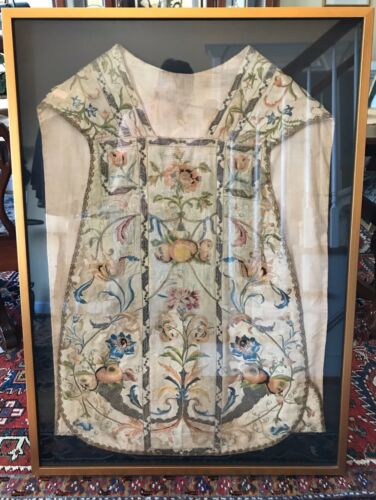-40%
18th C. Antique French Embroidered Christian Vestment Chasuble Anglican Priest
$ 263.47
- Description
- Size Guide
Description
Framed Restored and Preserved 17th/18th C. Antique French Embroidered Christian Vestment Chasuble Anglican Priest. Condition is Used. Shipped with FedEx Ground or FedEx Home Delivery.Chasuble: a sleeveless outer vestment worn by a Catholic or High Anglican priest when celebrating Mass, typically ornate and having a simple hole for the head.
Age: based on expert input And research , pattern, use of gold thread, and fabric, it is French style of late 17th/early 18th century chasubles.
Provenance: Most recently, it was given as a gift to a retiring Anglican priest. It was purchased by his church from the estate of Scaisbrooke Langhorne Abbot (see information on Mr. Abbot below) a well-known and highly respected portrait artist from Lynchburg, VA, who traveled Europe extensively, visiting museums and seeking unique works of art. The chasuble was professionally restored and preserved before being gifted. It is an extremely old, delicate work of art and should not be removed from it’s preservation framing. The chasuble is made from silk and linen and is edged in gold thread.
You are bidding on the titled Chasuble in good 300-year old condition. Some fabric loss pictured. See pictures as part of the detailed description. 9. $ calculated shipping by FedEx Ground to USA only and international shipping by the eBay Global Shipping Program if permitted by eBay.
Scaisbrooke Langhorne Abbot (16 January 1908–29 July 1985), painter, was born in Lynchburg and lived his entire professional life there. He was the youngest of four sons and fourth of six children of William Richardson Abbot, a Bedford attorney, and Lucy Lewis Abbot. From childhood Brooke Abbot, as he preferred to be known, wanted to be an artist and to work in Lynchburg. His first instructors in drawing were the noted Lynchburg art teachers, Sallie Lee Hunt Mahood and her daughter Carrie Mahood. Abbot's grandmother Elizabeth Dabney Langhorne Lewis and his aunt Elizabeth Lewis Otey encouraged him in his ambition and enabled him to tour the major museums and galleries in Europe. After attending the Virginia Episcopal School in Lynchburg, Abbot went to Paris when he was fifteen to study art under André Victor Edouard Devambez. At age seventeen Abbot entered the Pennsylvania Academy of Fine Arts in Philadelphia.
Abbot returned to Lynchburg and worked there as an artist until World War II. He served in the United States Army from 1942 to 1945, originally with the 89th Field Artillery. Wounded on Guadalcanal, he was sent to New Zealand for hospitalization. He spent part of the war as a medical illustrator for the 39th General Hospital. When he returned to Lynchburg, Abbot resumed his artistic career, and he became the most popular portrait painter in the area. He went elsewhere when commissions required but continued to live and work in Lynchburg, where he specialized in painting portraits of local citizens. His likenesses of children were especially sought after. He worked in a contemporary, Postimpressionist style that employed bright colors to produce paintings radiating great warmth. For his own pleasure he frequently sketched relatives and friends and painted floral still lifes. His works included murals, perhaps the most notable being one for the old post office in Lynchburg, and he painted theater scenery for the local little theater, in which he sometimes acted. A gregarious man, he was known also for his wit and humor.
Many of Abbot's paintings are privately owned, and some are unsigned. Others belong to the Virginia Historical Society, the American Philosophical Society, the University of Virginia, Washington and Lee University, and the Albemarle County courthouse, for which he did a notable set of portraits of Thomas Jefferson, James Madison, and James Monroe. Abbot painted on private commission and never entered any competitions or mounted any special exhibitions, so that he was not widely known outside of the Virginia Piedmont or the large circle of his family and friends. Although he was demanding of his subjects during the many hours of posing required for portraits, he often developed a special rapport with children, whom he permitted to call him "Brookie." Some of his young subjects returned to visit so often that Abbot, a bachelor who enjoyed the company of the youngsters, eventually established Thursday afternoon "at homes" for children. Brooke Abbot painted until the day that he died of cancer on 29 July 1985. He was buried in Saint Stephen's Episcopal Church Cemetery in Forest, Bedford County.




















